
Design Data Collection and Consumption Analysis
Customized Refrigerator
Overall
The project explored the potential of customising home appliances, particularly refrigerators, based on varied user needs. It identifies the demand for modular, flexible, and personalised features, catering to lifestyles from single individuals to large families. The research includes a model-based experiment, allowing participants to adjust fridge capacities, layouts, and functions. Key findings reveal a high interest in personalisation, with a specific emphasis on functional and aesthetic aspects, aligning with trends in user-centred, smart home innovations.
Project Duration
2 months (Nov-Dec, 2020)
Personal Project
NCTU Fall Semester 2021
Method&Tool
Experimental Design/Survey/Interview/Rhino/ Shape Diver/Grasshopper
A new lifestyle of Smart Home
Smart home appliances have surged in popularity, with sales growing sevenfold in three years and intelligent refrigerators up by 177%. This growth is driven by user-centric designs, personalised features, and smart interfaces, transforming homes into multifunctional spaces like gyms, offices, and entertainment venues. To meet these evolving needs, future designs should focus on flexible, customisable, and multifunctional products, allowing users to seamlessly integrate appliances into their living spaces.
Customized Home Appliances: Refrigerators
As family dynamics change, expanding refrigerator capacity often becomes necessary. While buying a second fridge is common, space constraints can be an issue. A modular refrigerator, customisable in size, door orientation, and functions like water dispensers or ovens, offers a flexible solution. Users can adjust the storage space over time, eliminating the need to purchase new appliances as needs evolve.
Market Case Study
The Samsung "BESPOKE" series refrigerators offer a wide range of customization options and multi-color panels to make them more lively and personalized in the kitchen. In addition, this series allows users to decide on the color scheme, door pattern, sizes, and forms of use to meet the needs of different environments. The "Cube" series offers three unique models of small refrigerators: Wine, Beer, and Beauty, with a stackable design that fits perfectly into all interiors and any home corner.


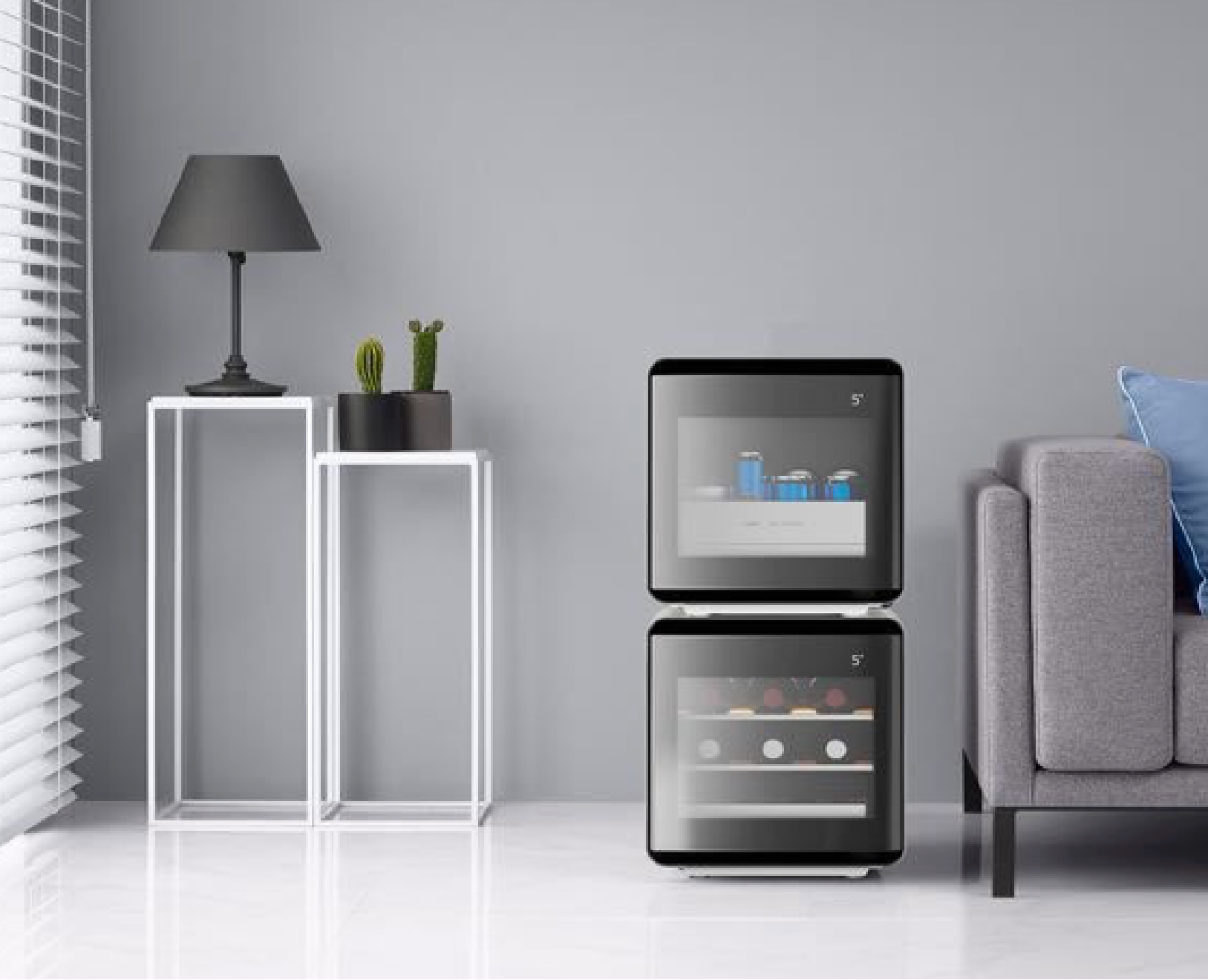

The Purpose of Study
To plan a customized service process for different groups, collect and analyze data, optimize product design to improve service content, provide personalized services to individuals, and evaluate business profitability to establish a business model.
Observe the respondents' daily use of refrigerators.
The extent to which the existing consumer market influences the purchase of a refrigerator. For example, shopping malls tend to sell well-configured models, or they tend to sell a single trend type that consumers cannot adjust.
Inquire about the improvements the respondents expect from customized products for existing usage.
🧑🏻🍳
User Condition
Purchase Habits & Food Storage Planning
🧺
Investigate respondents' planning for food storage, such as the proportion of refrigerated and frozen capacity allocation. This reflects their dietary preferences and purchasing habits.
Placement Space & Desired Form
🏠
What features or preferred styling are most important to consumers?
Find out whether "usage" or "form" is a priority for the test subjects.
Can we help consumers plan the ideal product to fit their lifestyle?
We collected respondents' opinions on how they would like to display their refrigerators. For example, a fridge does not have to be adjacent to a wall; it can be formed like a building block as part of a center island, bar, sofa, or other furniture or placed in a non-kitchen space, studio, or social room.
🪄
Service Process Experience
Preferences & Consumer Imagery
💝
Find out the public's preference.
Customization will increase the cost of production and the amount of money respondents are willing to spend on customized goods.
💭 Therefore, I conducted experiments and parametric models to investigate the correlation between products, home habits, and usage situations for different customer groups.
Experimental Design
Customized parametric models are the main experimental content, combined with pre-test and post-test questionnaires.
■ Fridge capacity analysis
for a single person (about 100L)
Easy to carry, lightweight / Suitable for boarders, renters, or placed in the office
for Nuclear family (about 300L)
Suitable for 2-3 people / Mostly slender type / Less space-consuming in terms of placement
for Small family (about 500L)
Suitable for five people / They were usually designed with three or more doors / Suitable for families with more contents
for Extended family (500L or more)
Suitable for large families of more than six people / Double door to open is the most popular type / The price is relatively high
■ Survey
1. Respondent
Three different groups, including independent living, couples, and families
2. Personal Information
Gender, age, residence information, cooking habits, frequency of refrigerator use
3. Existing Refrigerator Information
Approximate size, internal space configuration, satisfaction with existing refrigerators
4. Needs and Habits
(Short-answer questions) For example, I often need to chill many drinks, cook many ingredients, and buy ingredients once a month, so I need more refrigeration space, etc.
5. The Space to Place the Refrigerator
(Short-answer questions) For example, I want to put it in the living room so guests can get their drinks quickly.
6. Future Form
(Short-answer questions) Have you considered new ways to display the refrigerator beside the kitchen or match it with different furniture?
7. Additional Needs
(Short-answer questions) What additional functions do you want to add?
We explain how to operate the parameter model in a way that respondents can do in 10 minutes.
■ Customized process introduction and instruction
STEP 1 : Model components introduction, including various capacities, functions and materials
M
S
L
STEP 2 : Arrange freely in the square according to the usage habit
STEP 3 : Select the type of handle (horizontal or straight), and decide the direction of the opening and the position of the handle.
Users can place the horizontal handle in the upper, middle, and lower positions
Users can place the straight handle on the left or right and in different height positions.
STEP 4 : Decide on the refrigerator interior (door basket or size transparent blue or shelves)
■ Testing with Customized Platform "ShapeDiver"
Experimental Results
Part of the experimental samples
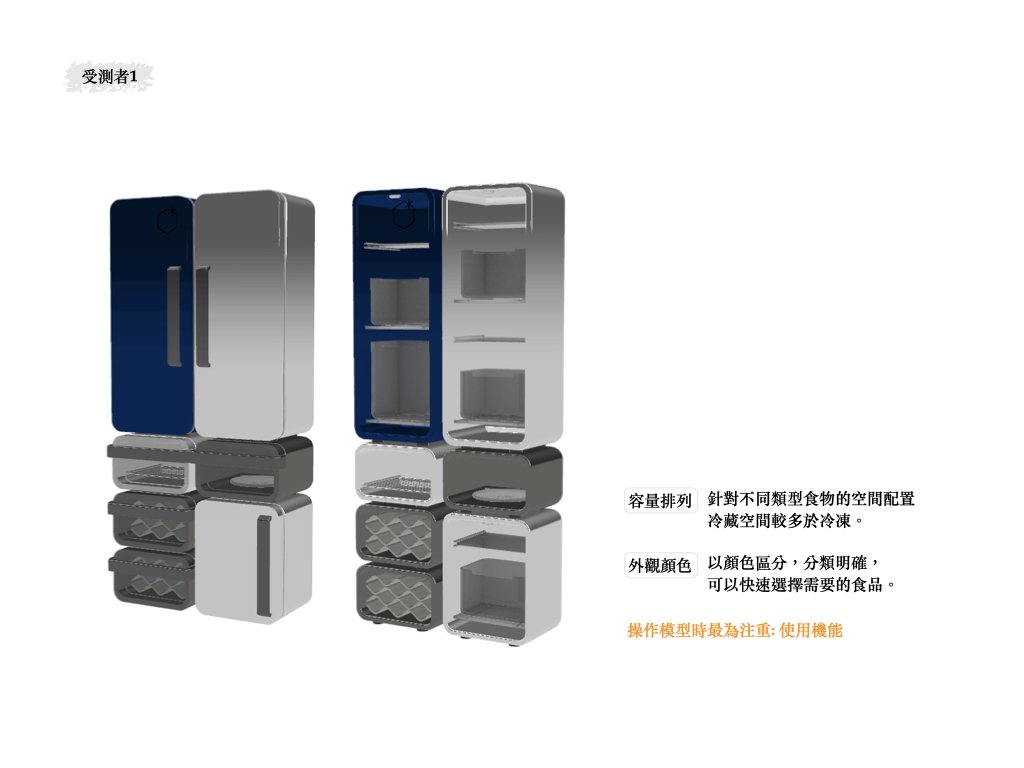
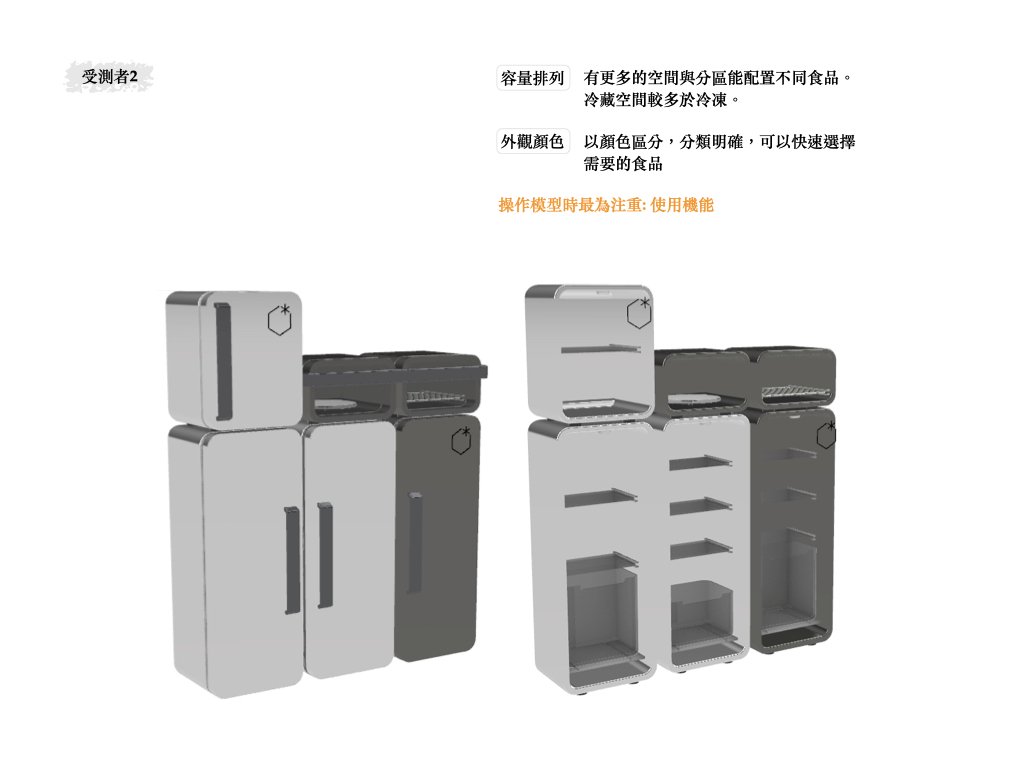
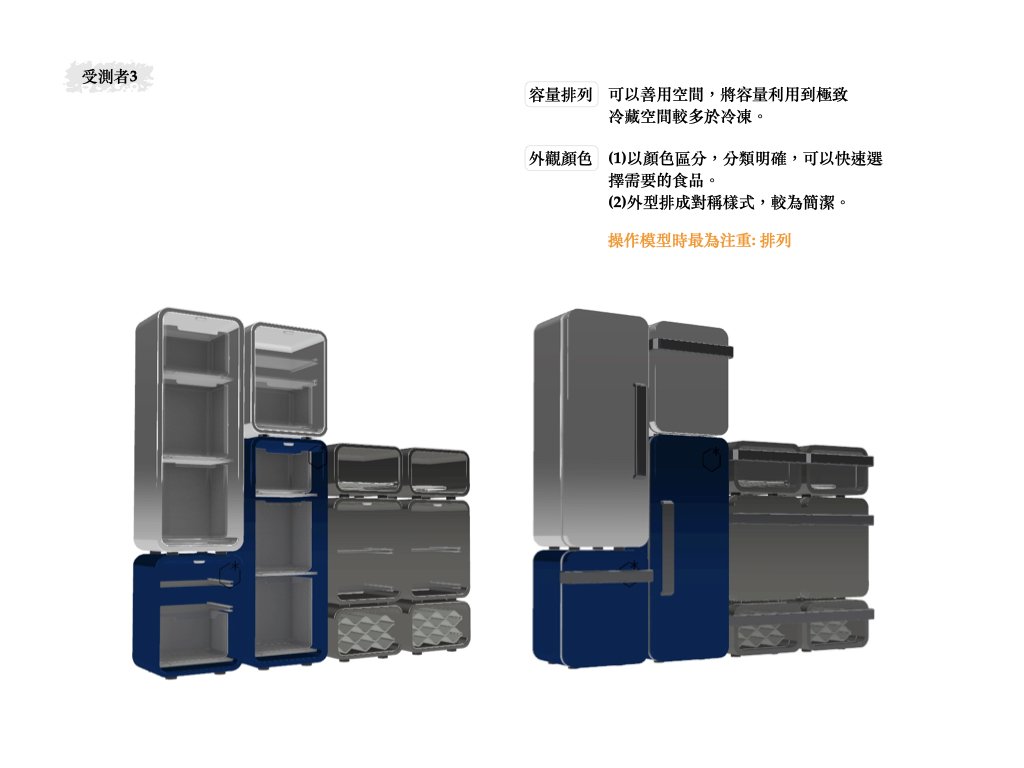

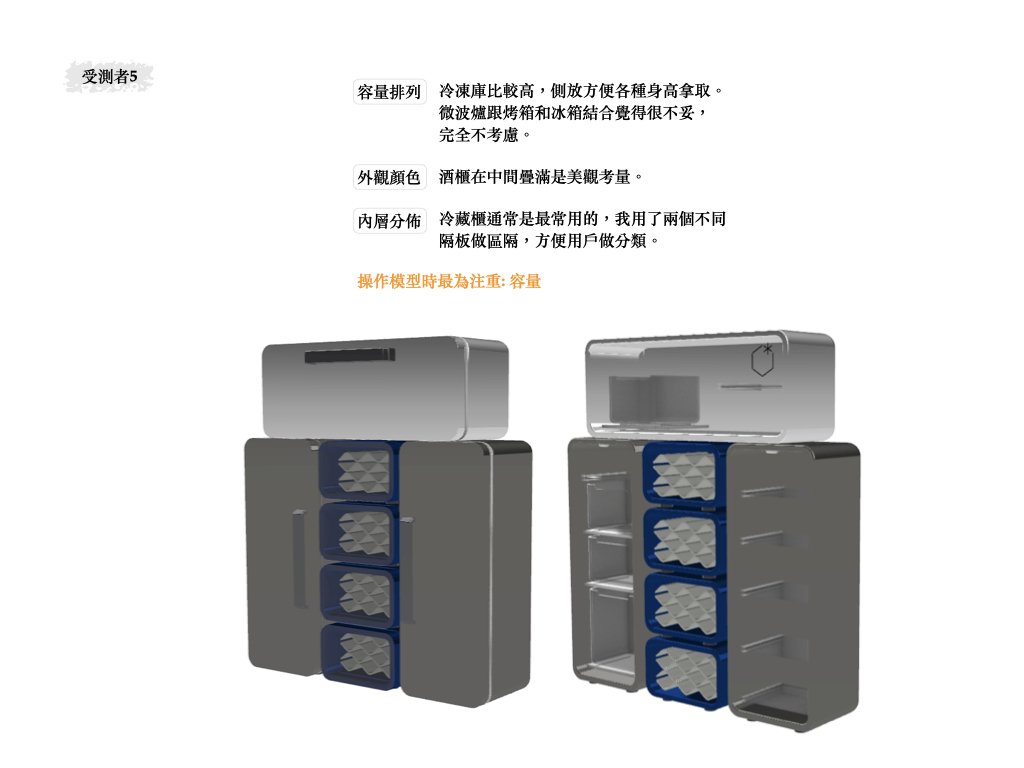
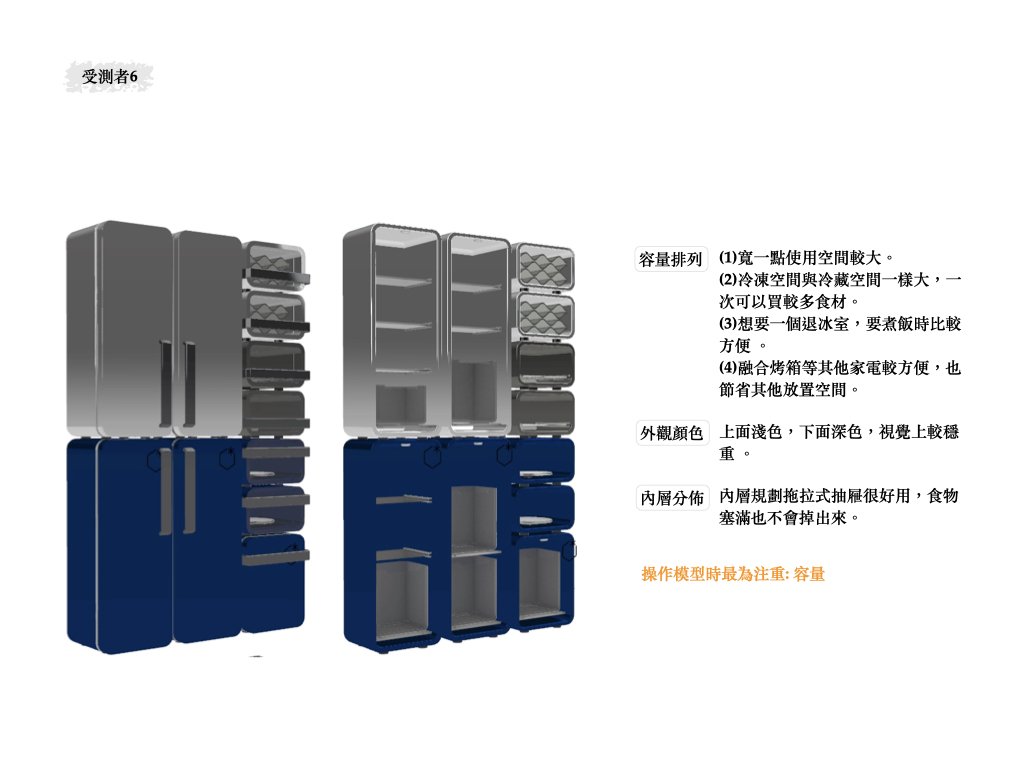
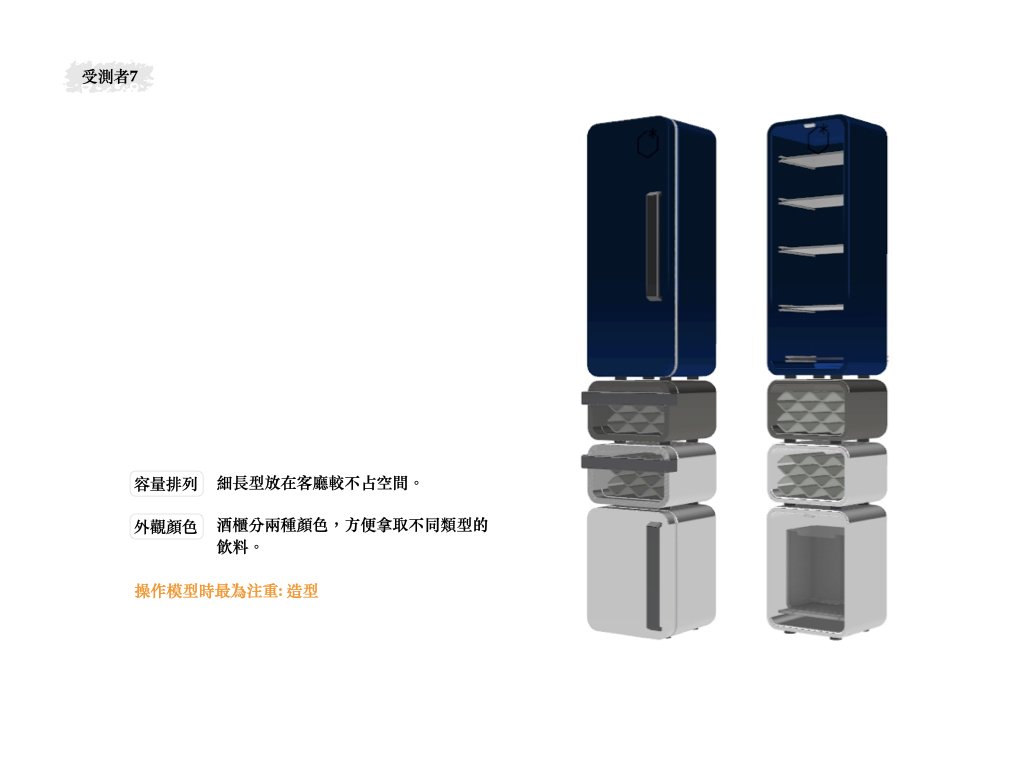

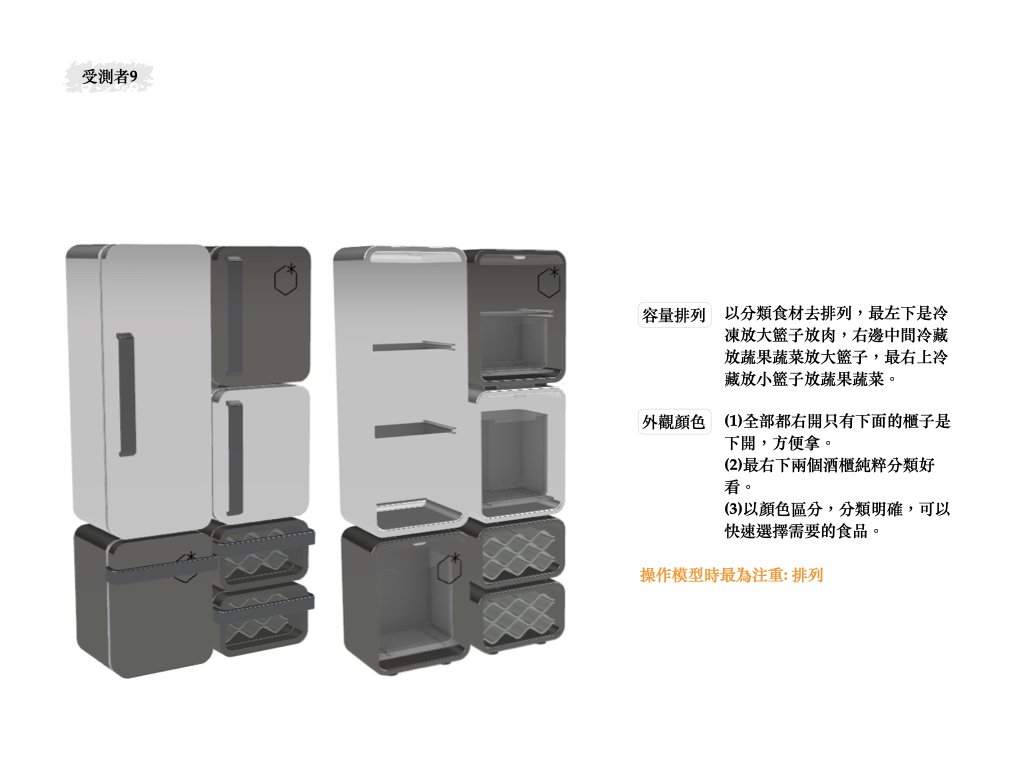
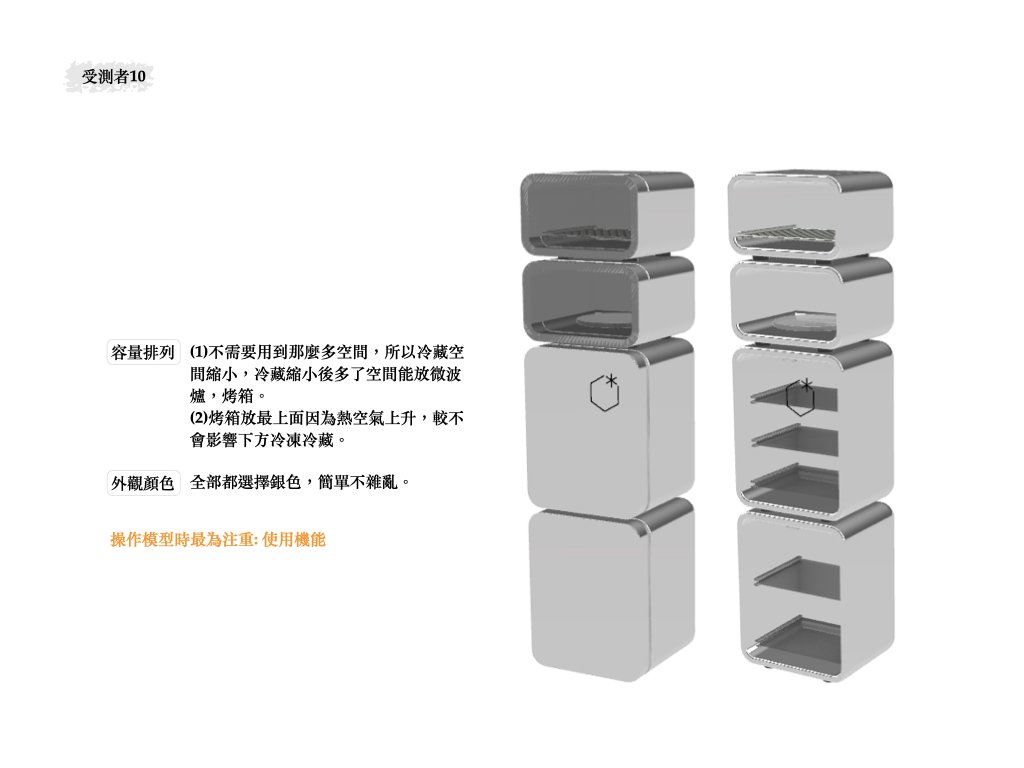
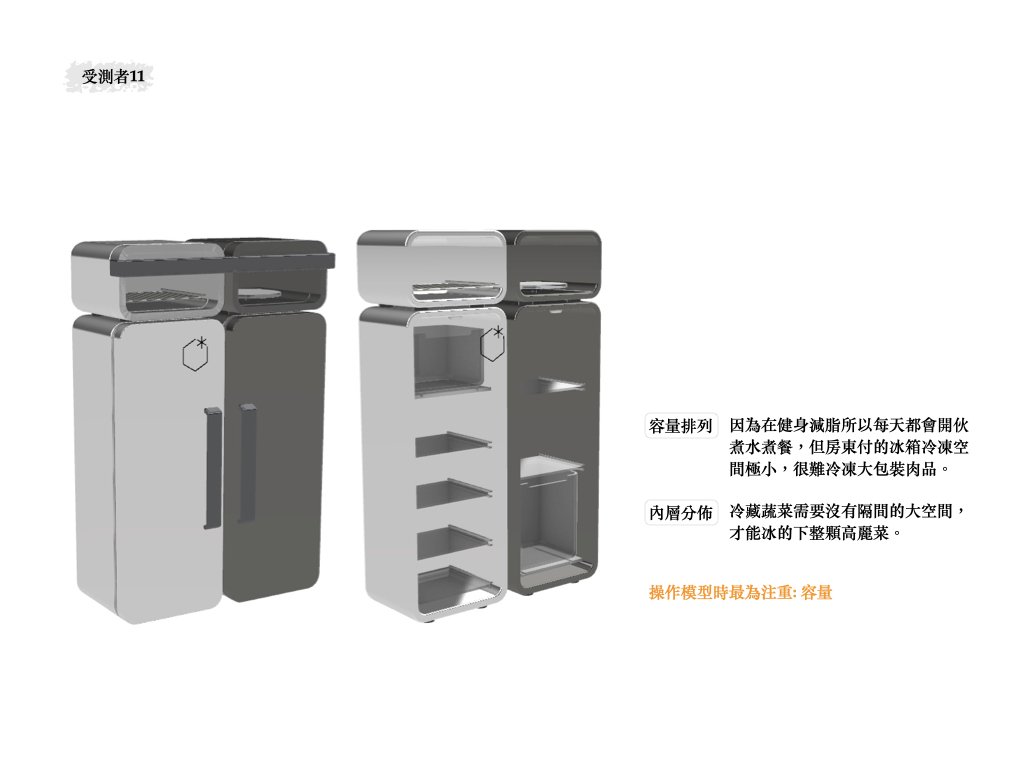
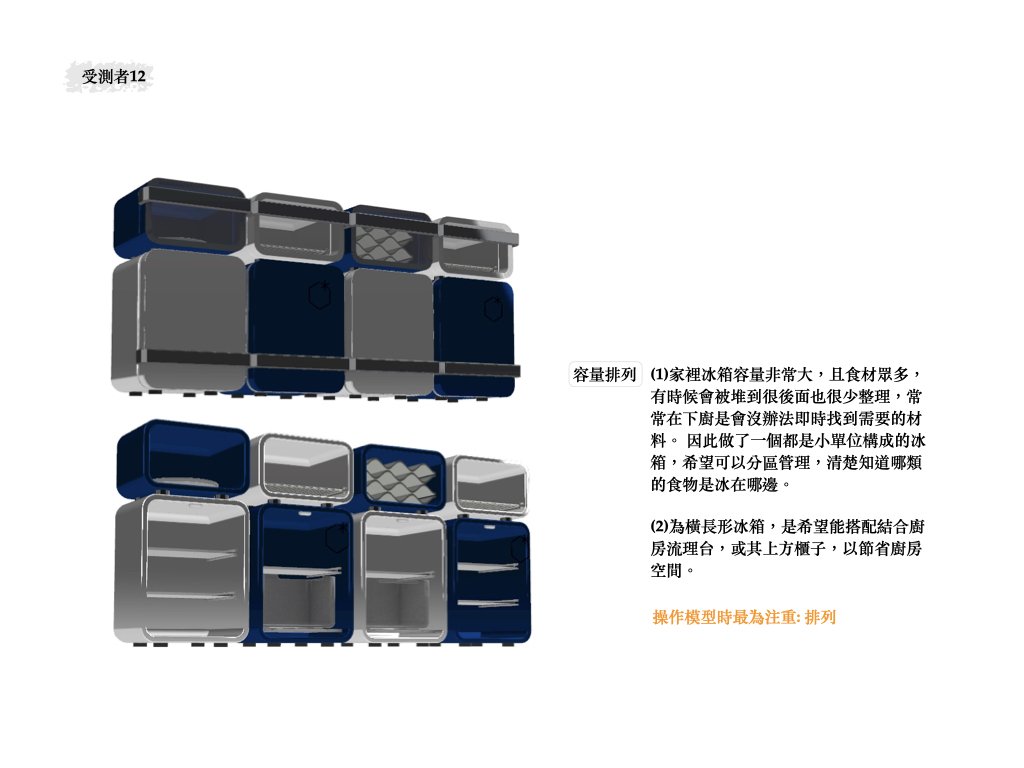
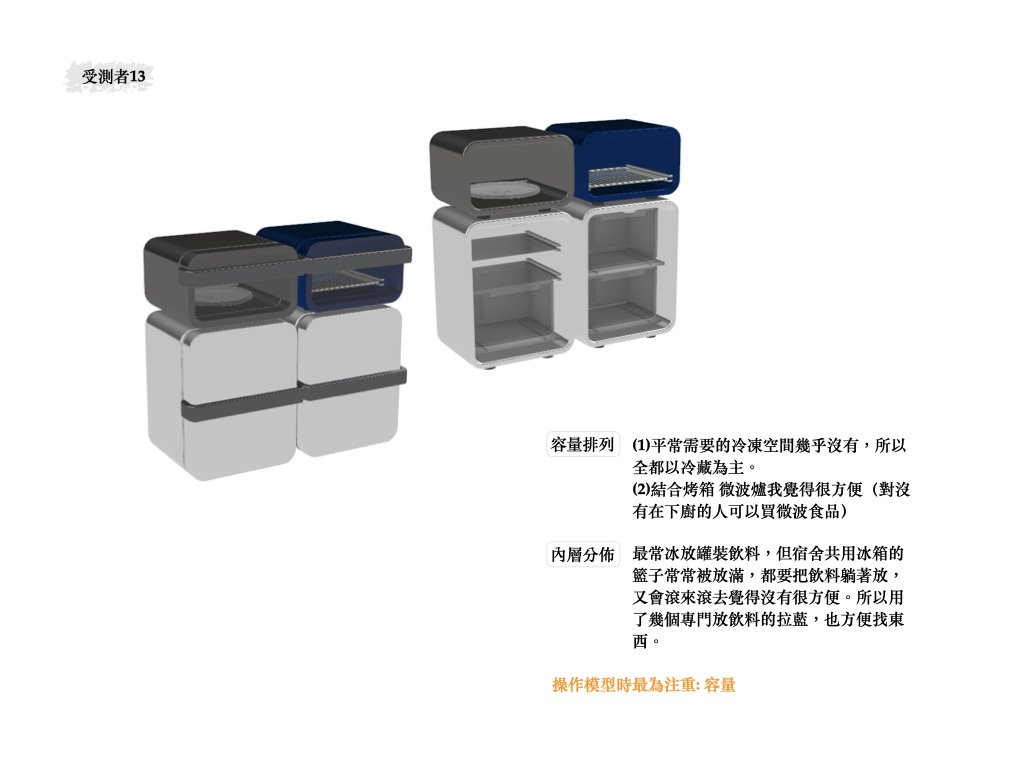
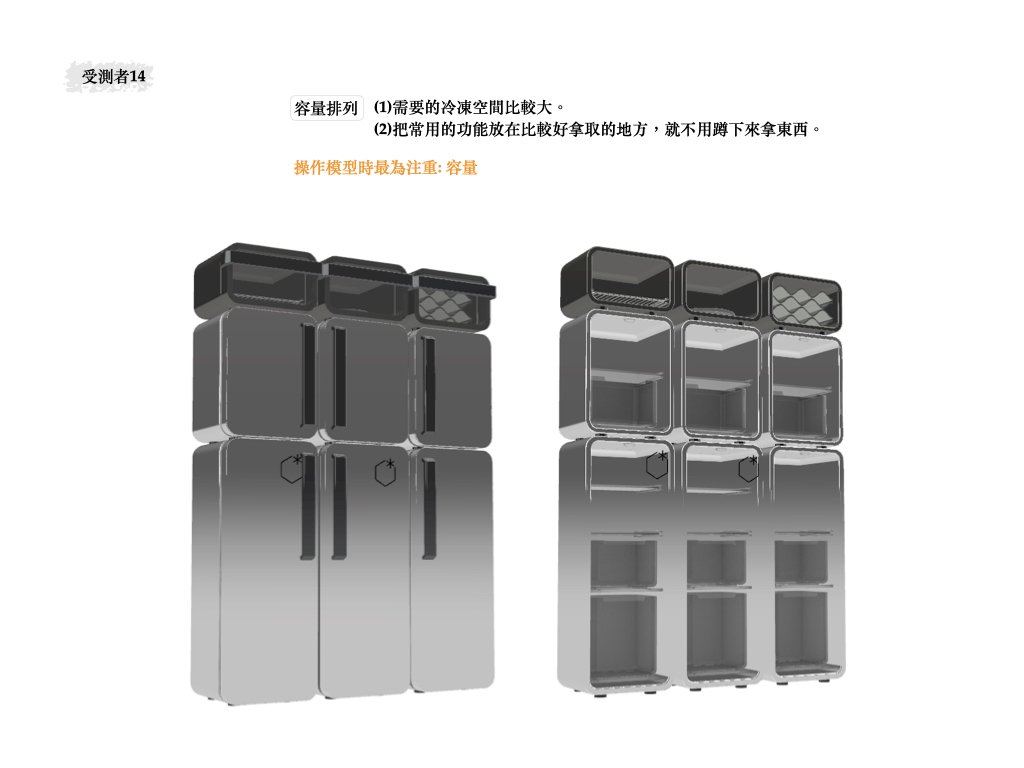
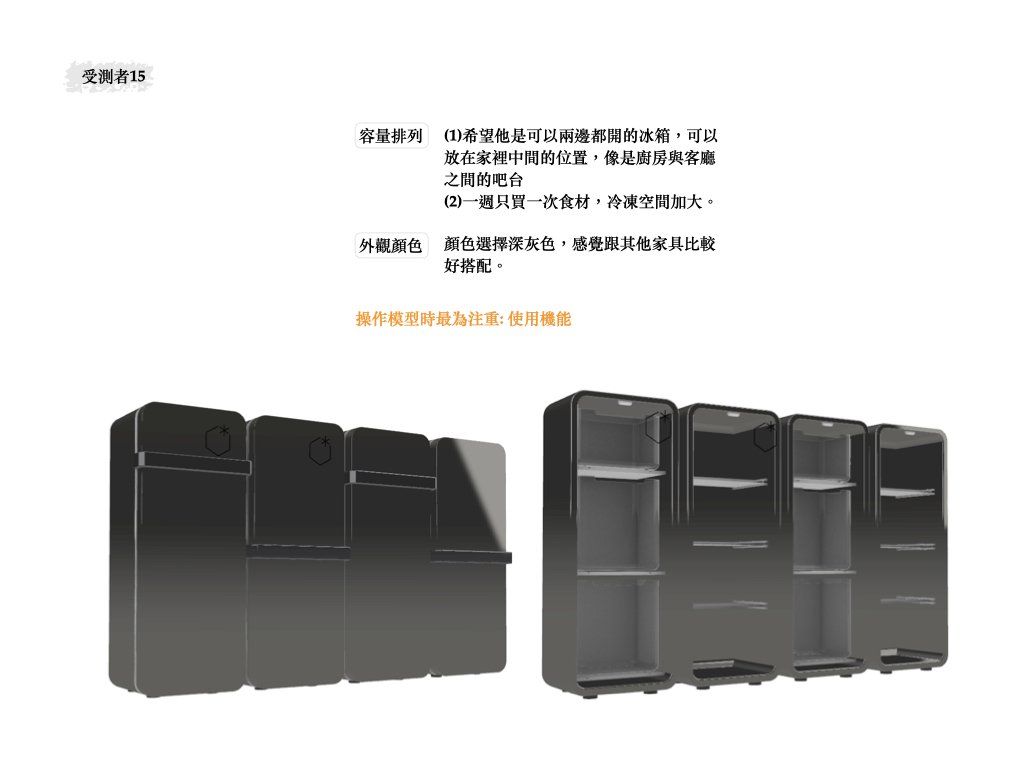
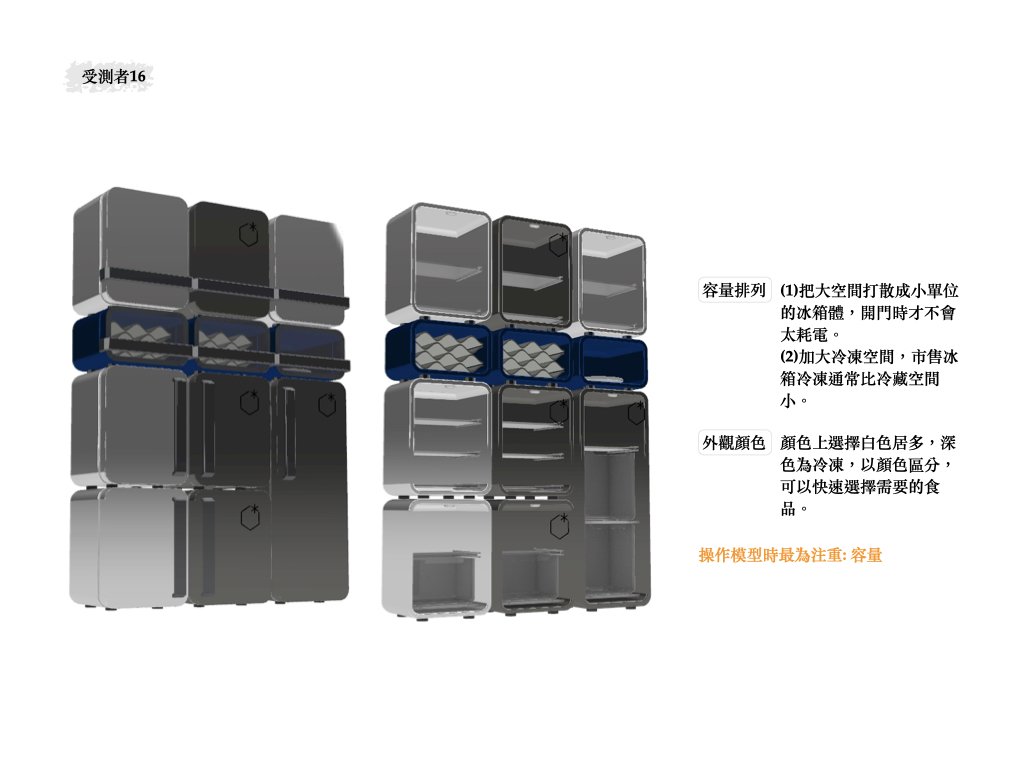
Sample Composition
👥
Living Types and Cooking Habits
🍴
Existing Refrigerator Information
🧊
Future Frige Usage Scenarios
🏠
Placing Space
🛋️
Multi-functional Use Across Spaces: Users prefer refrigerators placed in various accessible locations throughout the home, indicating a need for flexibility and multi-functional use beyond just the kitchen.
Social Convenience: Placing refrigerators in the living room was popular, especially for hosting guests. This suggests a trend towards making food and drinks easily accessible in social areas, aligning with modern lifestyles that value hospitality and shared spaces.
Centralized Access: Many participants like positioning the refrigerator between the kitchen and living room, providing convenient access from both areas. This points to a need for shared accessibility, especially in open-plan living spaces.
Personal Space and Hygiene: Many prefer to keep refrigerators in personal or private spaces, like bedrooms or personal lounges, to avoid hygiene concerns and prevent food theft. This implies a desire for privacy and control over food storage, especially in shared living environments.
Relief for Overcrowded Kitchens: Some respondents value placing the refrigerator outside the kitchen to alleviate congestion. This suggests that limited kitchen space is a common issue, and a well-placed refrigerator could help manage space more effectively.
Safety Considerations: The preference for placing refrigerators in kitchens with dedicated electrical plugs shows safety awareness, particularly for high-power appliances. This highlights a practical consideration for safety and proper appliance installation within the home.
Display Style
💡
Space-Saving Design: Many participants want to integrate the refrigerator with existing furniture (e.g., coffee tables, wine coolers, or low stools), aiming to save space. This indicates a strong preference for compact, multifunctional appliances that blend seamlessly into smaller living spaces.
Blending with Décor: There’s a clear desire to merge refrigerators with surrounding furniture, such as sofas or cabinets, to reduce any sense of abruptness in the room. This suggests that users want appliances that harmonize with home aesthetics rather than stand out as traditional, bulky appliances.
Multi-Purpose Furniture Integration: Combining refrigerators with headboards or partitions reflects a trend towards multi-purpose furniture. People are looking for appliances that serve dual functions, adding value and convenience to personal spaces, such as having drinks readily accessible before bedtime.
Discreet Storage Solutions: Integrating the refrigerator within cabinets or as part of hanging units supports a minimalist approach. This approach helps reduce clutter in crowded spaces like kitchens, blending the appliance and enhancing a sleek, unobtrusive look.
Innovative Functional Design: Some suggestions, like using the refrigerator surface as a floor mirror or placing it as a double-sided unit on a kitchen countertop, reflect users' interest in unique and innovative design elements that make the appliance more versatile and visually attractive.
Adaptability for Compact Living: Combining refrigerators with small, space-efficient furniture pieces (e.g., end tables or compact kitchen islands) aligns with the needs of dormitory or small apartment living, where space optimization is crucial. This shows a growing market for flexible and modular designs that adapt to tight spaces.
Function Integration
⛓️💥
Quick Access & Energy Efficiency: Features like food maps and transparent doors save time and energy, showing a need for quick, eco-friendly food access.
Health Tracking: Calorie counting, expiration alerts, and food warnings highlight users' focus on health and food safety.
Automated Stock Management: Auto-order functions reflect a demand for convenience by automating essential grocery restocking.
Streamlined Food Retrieval: Vending machine-style dispensing appeals to users seeking quick access to specific food items.
Sustainable Energy: The treadmill-powered refrigerator concept shows interest in eco-friendly, energy-saving solutions.
All-in-One Beverage Station: Integrating water dispensers, smoothie machines, and recipe screens meets the needs for a versatile, home-friendly drink and meal prep.
IoT Connectivity: Seamless integration with other smart devices appeals to users who want a fully connected, automated home experience.
Result and Discussion
💭 After the complete experimental process, 93.8% of the respondents think they better understand their needs when purchasing a refrigerator. (Figure 1)
💭 37.5% of the respondents paid attention to the capacity and performance respectively, when operating the custom model, followed by the arrangement of the modular block. (Figure 2)
💭 Half of the respondents would use the color of the external panel to classify and differentiate the refrigerator's functions.
💭 Most of those who have the habit of cooking choose a more oversized freeze compartment, while those who do not select a larger fridge compartment.
💭 1/3 of the respondents think that the placement of wine cabinets helps improve refrigerators' aesthetics.
💭 The internal shelves will be adjusted according to the height and size of the ingredients to be stored. (especially cabbage, meat, and drinks)
💭 Most respondents' ideas are still limited to the traditional upright refrigerator.
💭 Gender preference for color: women mostly choose silver with dark gray as a supplement, while men mostly choose dark gray and dark blue panels.
1. The sample is limited to a single group, mainly young people (20-29 years old), who tend to accept the new concept of refrigerator design, so there may be different results for other age groups.
2. Since the concept of customized refrigerators is not yet widespread, and most test subjects are not familiar with smart home appliances, would the results remain the same if we conduct this experiment on people concerned about smart homes?
100% of the respondents said they would be willing to try such a customized refrigerator if available.
93.8% of respondents considered that this experiential activity would increase their interest in selecting products.
✨ Future Home Appliances and Customized Services
We broadly grouped the experimental results into three consumer groups.
Remains in the traditional home furnishing type, thinking that home appliances are just as good as low cost and only ensure the basic needs of users.
Transforming to personalized homes, which are more receptive to customized and higher-priced goods that can satisfy personal preferences and usage habits to a greater extent.
Transforming to smart homes and smart home appliances are the priorities when selecting products. They hope those home devices will be more user-friendly, interactive, and have additional functions.
Consumption upgrades have led to more people focusing on the appearance of products and new user experiences, and custom-made home appliances at high-cost gain increasing preference. More people value the quality of life and are willing to spend a high price to customize products that meet their needs.































